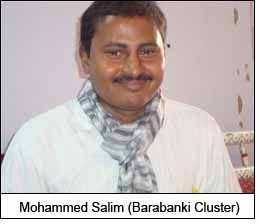Interviews
Handloom clusters ensure inclusive growth for weavers
20 Jan '11
7 min read

Mohammed Salim (Barabanki Cluster)
“The fourth and of the main component is the up-gradation of handlooms. In a few clusters we have introduced a five-wheel system which helps increase productivity and reduces fatigue in the weaver. Weavers from a cluster are taken to visit other clusters to understand the implementation of the initiatives for the development of the clusters.
“The fifth and last component, but as important as machinery up-gradation, is design development. We have taken help from graduates of institutes like National Institute of Design (NID) and National Institute of Fashion Technology (NIFT) to help them produce handloom goods with contemporary and current designs and trends.
“We have provided a corpus of Rs 500,000 to each of the clusters for purchasing raw materials like yarns etc. As of date CFCs have been set up in around 10 clusters and 13 clusters have set up dyeing houses. A CFC has a display room where handloom products are displayed, meeting room, a yarn bank, a testing lab to test quality of yarns and fastness of dyes in fabrics and a weaving shed which has attachments like jacquards etc, where the weaver can come and train himself on these handlooms. These handlooms are also used to produce new samples.
“Raw material supplies were assured through the National Handloom Development Corporation (NHDC) which procures yarn from the market and supplies it to the yarn bank. The ultimate objective of this scheme was to enhance the wages of these handloom weavers and ensure that they are adequately compensated for their produce, reduce dependency on middle-men by organizing expos like the one in Ahmedabad across India.
“Now the government has initiated a mini-cluster scheme for better management which is given Rs 6 million over a period of three years. These clusters can be started with just 300 handlooms. In terms of objectives, in the assessment that was conducted a few months back, it was reported that wages have enhanced for around 15-20 percent weavers. However clusters in South India have reported higher percent of enhancement of wages amongst weavers because they are mainly supported by government agencies, he concluded by saying.
Fibre2fashion next spoke to a few weavers from amongst the stalls put up the handloom expo. Mohammed Salim from Barabanki Cluster in Uttar Pradesh who informed that their incomes had shot up ever since the concept of handloom clusters was implemented. Previously he was just a weaver working under a master weaver, but today he has 15 other people, including weavers working under him and indirectly 30 others benefit from his activities.
He takes part in each and every expo organised by the DC (Handlooms) across the country, where he comes across local consumers as well as bulk buyers, he gets very big orders from these buyers and sometimes he passes on these orders to other SHGs or other clusters as sometimes he gets orders beyond his production capacity. He has even exported his products to overseas countries as his products meet the stringent quality parameters demanded by overseas buyers.
“The fifth and last component, but as important as machinery up-gradation, is design development. We have taken help from graduates of institutes like National Institute of Design (NID) and National Institute of Fashion Technology (NIFT) to help them produce handloom goods with contemporary and current designs and trends.
“We have provided a corpus of Rs 500,000 to each of the clusters for purchasing raw materials like yarns etc. As of date CFCs have been set up in around 10 clusters and 13 clusters have set up dyeing houses. A CFC has a display room where handloom products are displayed, meeting room, a yarn bank, a testing lab to test quality of yarns and fastness of dyes in fabrics and a weaving shed which has attachments like jacquards etc, where the weaver can come and train himself on these handlooms. These handlooms are also used to produce new samples.
“Raw material supplies were assured through the National Handloom Development Corporation (NHDC) which procures yarn from the market and supplies it to the yarn bank. The ultimate objective of this scheme was to enhance the wages of these handloom weavers and ensure that they are adequately compensated for their produce, reduce dependency on middle-men by organizing expos like the one in Ahmedabad across India.
“Now the government has initiated a mini-cluster scheme for better management which is given Rs 6 million over a period of three years. These clusters can be started with just 300 handlooms. In terms of objectives, in the assessment that was conducted a few months back, it was reported that wages have enhanced for around 15-20 percent weavers. However clusters in South India have reported higher percent of enhancement of wages amongst weavers because they are mainly supported by government agencies, he concluded by saying.
Fibre2fashion next spoke to a few weavers from amongst the stalls put up the handloom expo. Mohammed Salim from Barabanki Cluster in Uttar Pradesh who informed that their incomes had shot up ever since the concept of handloom clusters was implemented. Previously he was just a weaver working under a master weaver, but today he has 15 other people, including weavers working under him and indirectly 30 others benefit from his activities.
He takes part in each and every expo organised by the DC (Handlooms) across the country, where he comes across local consumers as well as bulk buyers, he gets very big orders from these buyers and sometimes he passes on these orders to other SHGs or other clusters as sometimes he gets orders beyond his production capacity. He has even exported his products to overseas countries as his products meet the stringent quality parameters demanded by overseas buyers.
Popular News
Leave your Comments
Editor’s Pick
































-Ltd..jpg?tr=w-120,h-60,c-at_max,cm-pad_resize,bg-ffffff)





.jpg?tr=w-120,h-60,c-at_max,cm-pad_resize,bg-ffffff)
.jpg?tr=w-120,h-60,c-at_max,cm-pad_resize,bg-ffffff)






